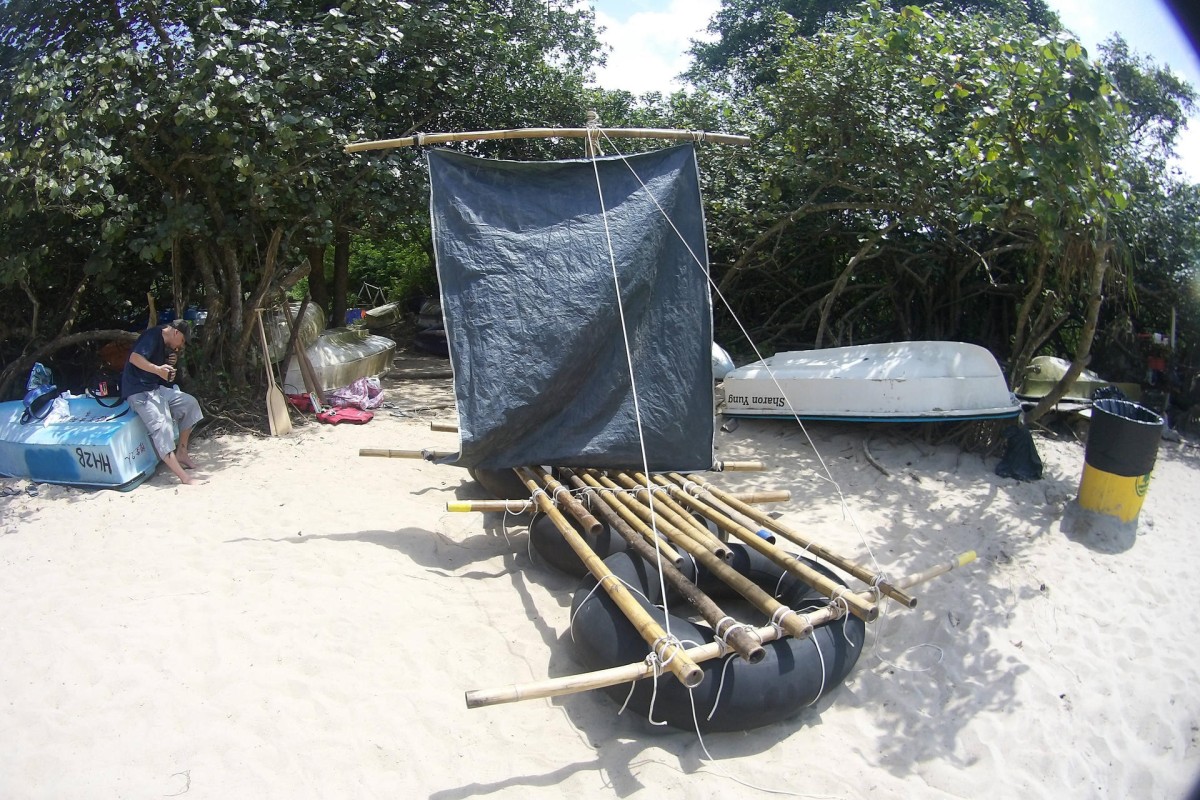 Not ideal for a long cruise, but it floats.
Not ideal for a long cruise, but it floats.I survived survival skills! When I was told that I would need to build a raft that could float on water, I was nervous, if not terrified. For someone who can't swim and sucks at anything DIY, it was always going to be a challenge.
Other parts of a traditional survival skills workshop - realistic shelter building, fire building and bamboo cooking - are not allowed in the marine park due to environmental and conservation laws. I was a bit disappointed by that. Not that I wanted to cook, but it would have been cool to learn how to build a shelter or start a fire.
"Great, now I'm gonna die on the raft I build," I texted everyone prior to my experience. Jaymz, my instructor from Dragonfly, wasn't helpful either.
"It should take no longer than a few hours - unless we get blown out to sea," he said, as if I wasn't nervous enough.
By the time I got to Hoi Ha Wan Marine Park, I'd sweated more than I normally do in a whole year.
I did get some help from Dragonfly. When I met up with Jaymz, a pile of bamboo sticks and three big, rubber-ring style tubes were waiting for me. This was to save us from having to look for substitutes like dead branches or logs on the beach. There was also a huge plastic cloth to serve as a sail!
Building a raft was not as complicated as I had imagined. What I didn't realise - or maybe it was my lack of common sense - is that knowing how to tie knots is an extremely useful skill.
First, Jaymz laid three rubber tubes on the beach. He taught me how to get an idea of how big a raft would be based on the size of the tubes.
Then we laid out all the bamboo sticks, which were all different lengths. We categorised them into two groups, longer and shorter. It's actually a lot like bamboo scaffolding; you lay the sticks crossing each other and tie knots to bind them together.
I had to use all my strength to make the knots tight enough. I didn't want to be told that we had some loose ends once we got in the water.
"If you have doubts, normally it's a knot you have to redo," Jaymz told me.
After connecting all the bamboo sticks and tubes, and getting my hands really dirty, Jaymz and I still had to figure out a way to put our sail up.
Even though he had built hundreds of rafts, Jaymz had never tried a sail.
This time, the knots weren't enough. Jaymz tied the sail to the pole (sadly, I wasn't tall enough to do that), but the wind pulled at the sail and loosened the knots.
Luckily, he had zip-ties. The humble yet unbreakable zip-ties were able to hold up our mighty sail.
We were finally ready to go sailing!
But not before Jaymz pulled something out of his enormous bag.
"Do you know what this is?" he asked.
"I admit, I'm not great at building rafts, but that doesn't make me an idiot," I said to myself. It was a life jacket.
That's when my usually smiley instructor got serious. Turns out it was a personal floatation device (PFD). There is one crucial difference between a PFD and a lifejacket. If you fall into the water unconscious and end up face down, a life jacket turns you onto your back so that you are still able to breathe. A PFD doesn't do this, and is simply to give you some additional support. Any time you do any sort of outdoor sport or water activity, you will be given a PFD. Lifejackets are typically for emergency situations only.
After putting the PFD on and adjusting it until it was so tight that I could barely breathe, I realised I had another problem - I needed my action camera with me on the raft, but there was no way I could hold it while sailing.
Once again, knots came to the rescue. Jaymz helped me to tie one end of a rope to a ring on the PFD and the other to my camera. By that point, I was completely convinced that knots were the best invention ever, given their ability to connect almost anything.
Sailing in Hoi Ha Wan was relaxing, although paddling was hard. I felt like I'd put 120 per cent of my effort into paddling, but the raft barely moved forward.
Luckily for us, we weren't desperately trying to escape an isolated island or cross the globe, so we could just enjoy ourselves and let the sea breeze cool us down.
Don't forget to check out the other stories from our Going Wild series!
